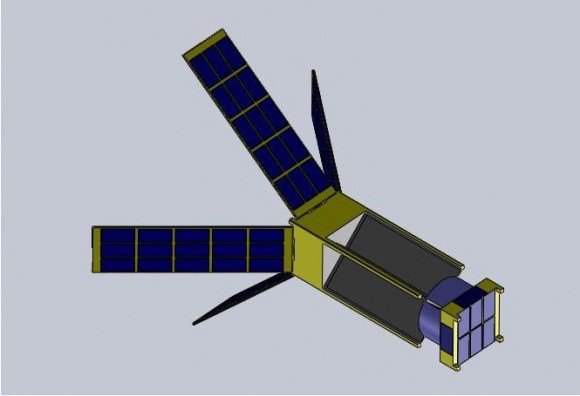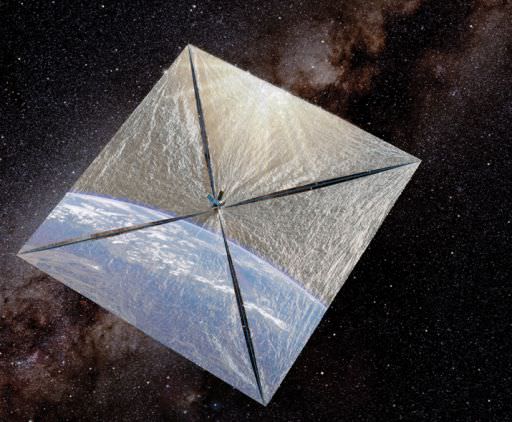[/caption]
On the 75th anniversary of astronomer Carl Sagan’s birth, the Planetary Society announced their plans to sail a spacecraft on sunlight alone by the end of 2010. Called LightSail, the project will launch three separate spacecraft over the course of several years, beginning with LightSail-1, which will demonstrate that sunlight alone can propel a spacecraft in Earth orbit. LightSails 2 and 3, will travel farther into space.
Sagan, co-founder of the Planetary Society was a long-time advocate of solar sailing.

Lightsail-1 will fit into a volume of just three liters before the sails unfurl to fly on sunlight.
On today’s 365 Days of Astronomy podcast, Sagan’s widow and collaborator, Ann Druyan said this project is a “Wright Brothers Kitty Hawk-type” enterprise of inventing and proving a new way of moving through the cosmos.
“On one episode of Cosmos, we wrote ‘We have lingered too long on the shores of the cosmic ocean. It’s time to set sail for the stars,'” she said. “And that’s what I was thinking when it became clear that we had the resources to mount this expedition, that we are serious at The Planetary Society. And at Cosmos Studios, my company which provided the principal support for the first 10 years of this project, we’re really serious about giving our kids a future in which science and technology is used in its most wise and benign and forward-looking possible way. That’s why I’m so thrilled and I just think if Carl were alive he would have been absolutely overcome at the notion that The Planetary Society is mounting its own space program, let alone its own launch.”
The solar sail project was boosted by a one-million-dollar anonymous donation.
Taking advantage of the technological advances in micro- and nano-spacecraft over the past five years, The Planetary Society will build LightSail-1 with three Cubesat spacecraft. One Cubesat will form the central electronics and control module, and two additional Cubesats will house the solar sail module. Cameras, additional sensors, and a control system will be added to the basic Cubesat electronics bus.
Reflected light pressure, not the solar wind, propels solar sails. The push of photons against a mirror-bright surface can continuously change orbital energy and spacecraft velocity. LightSail-1 will have four triangular sails, arranged in a diamond shape resembling a giant kite. Constructed of 32 square meters of mylar, LightSail-1 will be placed in an orbit over 800 kilometers above Earth, high enough to escape the drag of Earth’s uppermost atmosphere. At that altitude the spacecraft will be subject only to the force of gravity keeping it in orbit and the pressure of sunlight on its sails increasing the orbital energy.
Lightsail-2 will demonstrate a longer duration flight to higher Earth orbits. LightSail-3 will go to the Sun-Earth Libration Point, L1, where solar sails could be permanently placed as solar weather stations, monitoring the geomagnetic storms from the Sun that potentially endanger electrical grids and satellite systems around Earth.
The Planetary Society’s attempt in 2005 to launch the world’s first solar sail, Cosmos 1, was scuttled when its launch vehicle, a Russian Volna rocket, failed to reach Earth orbit.
For more information, see the Planetary Society’s LightSail Page.


Eventually solar sail craft could be used to propel interstellar probes. The sailcraft would have photons directed at it by a large Fresnel lens, which could columate light out to huge distances. The system could reach gamma = 1.4 or around 50% the speed of light. I think these types of interstellar probes could be lofted in not too many decades.
I work out the relativistic physics of this in my book “Can Star Systems be Explored?” If we wanted we could send probes to stars within 10 lightyears within the next 2 to 3 decades. Of course it will take about as much time to get data back from them. So maybe by the year 2070-80 our great grandchildren will learn about planets around epsilon Eridani.
LC
Sounds kinda goofy I suppose but is it possible that Reflected Light Pressure is the force causing all of the galaxies in the universe to apparently be accelerating away from one another?
The solar wind is a possible threat to human beings beyond the earthly magnetosphere. If the solar wind turns into a solar storm, ships far away from Earth’s save coast might be doomed.
Recently, I wondered how that fractious forces might be turned into useful powers.
One possibility to do so are solar sails. Among others. Hopefully, it will not be torn to pieces.
Perhaps we’ll see contests similar to those Arthur C Clarke wrote about in ‘Wind From The Sun’. [as well as travelling to the outer solar system of course]
Photon pressure might drive a sai, but not the entire universe into an expansion. This is seen in the Nichols radiometer. That is the closed glass bulb with a metal vane balanced on a pin/ The wings of the vane have different colors so one side absorbes photons and the other reflects photons. This results in a photon or light pressure on the vane, which starts spinning up.
The exapnsion of the universe has to do with the dynamics of the geometry of space or spacetime according to general relativity.
LC
What does the solar sail demonstrator mean for science?
The LightSail will not only demonstrate a new technology but also result in a lot of physics.
A large amount of data about the solar wind during every moment of operation will be aquired. We will learn a lot about the features of the solar wind. And also certainly new methods on how to protect ships against solar storms.
Directly there is no new science. It is just a way which craft could be directed to different targets without using as much rocket fuel or energy we must supply.
LC
The solar sail method will turn into a scientific adventure.
Just one example. As the solar wind pulls the sail there is a measureable change of speed and direction. That means that the properties of the solarwind at various locations can be continuously calculated and thus mapped. The results could have even influence on the prediction of the drag on satellites in earth orbit.
Moreover, to effectively conduct solar wind driven spaceflight, a lot of new theories and models will have to be established.
And the people that operate those ships will become experts in the physics of the solar weather. They will acquire very useful knowledge.
The propulsion is not the solar wind, but photon pressure. For the energy of a photon E = hbar*angluar-frequency the momentum of that photon is p = E/c. If that photon reflects off a surface so the photon momentum changes by p –> -p, then this requires the -2p change in photon momentum is countered by a 3p change in the momentum of the reflecting surface.
Solar wind, or the magnetopause environment of the solar system, might in the future play a role. If the solar sailcraft has a powerful magnetic field associated with it this can anchor the craft with the diffuse plasma environment. Now that there are two forces on the craft the navigation can begin to use a force of tacking, similar to the method used with sailboats to sail into a headwind. Of course gettng a large enough magnetic field is hard, as this adds weight and energy demands.
LC
Ouh, okay, LC …
thank you for the clarification.